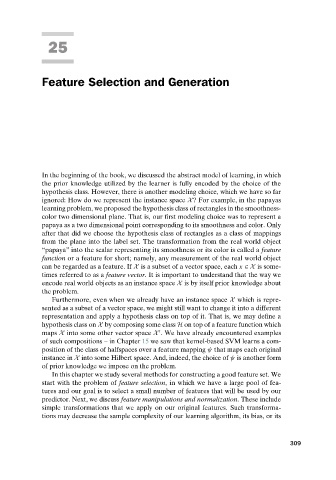Page 327 - Understanding Machine Learning
P. 327
25
Feature Selection and Generation
In the beginning of the book, we discussed the abstract model of learning, in which
the prior knowledge utilized by the learner is fully encoded by the choice of the
hypothesis class. However, there is another modeling choice, which we have so far
ignored: How do we represent the instance space X? For example, in the papayas
learning problem, we proposed the hypothesis class of rectangles in the smoothness-
color two dimensional plane. That is, our first modeling choice was to represent a
papaya as a two dimensional point corresponding to its smoothness and color. Only
after that did we choose the hypothesis class of rectangles as a class of mappings
from the plane into the label set. The transformation from the real world object
“papaya” into the scalar representing its smoothness or its color is called a feature
function or a feature for short; namely, any measurement of the real world object
can be regarded as a feature. If X is a subset of a vector space, each x ∈ X is some-
timesreferredto asa feature vector. It is important to understand that the way we
encode real world objects as an instance space X is by itself prior knowledge about
the problem.
Furthermore, even when we already have an instance space X which is repre-
sented as a subset of a vector space, we might still want to change it into a different
representation and apply a hypothesis class on top of it. That is, we may define a
hypothesis class on X by composing some class H on top of a feature function which
maps X into some other vector space X . We have already encountered examples
of such compositions – in Chapter 15 we saw that kernel-based SVM learns a com-
position of the class of halfspaces over a feature mapping ψ that maps each original
instance in X into some Hilbert space. And, indeed, the choice of ψ is another form
of prior knowledge we impose on the problem.
In this chapter we study several methods for constructing a good feature set. We
start with the problem of feature selection, in which we have a large pool of fea-
tures and our goal is to select a small number of features that will be used by our
predictor. Next, we discuss feature manipulations and normalization. These include
simple transformations that we apply on our original features. Such transforma-
tions may decrease the sample complexity of our learning algorithm, its bias, or its
309

